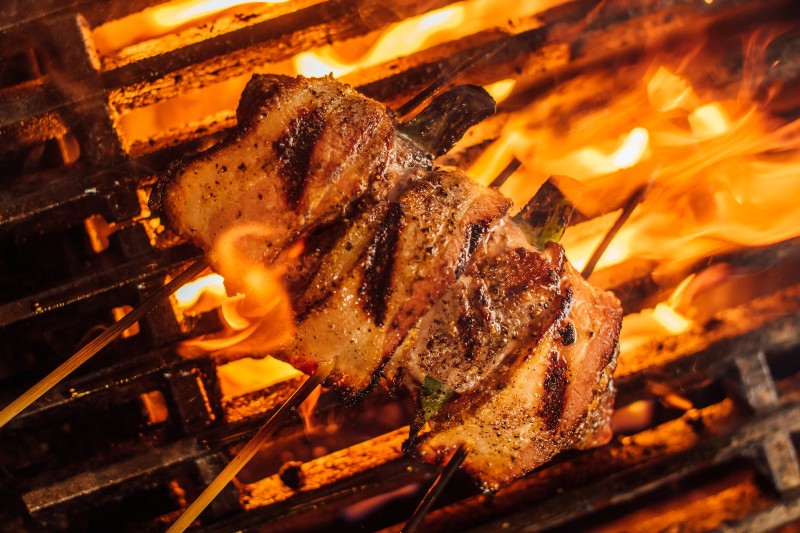
It’s that time of year again when we neglect our Dutch ovens, slow cookers, and air fryers for our outdoor char-grilling and smoking devices. It doesn’t matter if you’re cooking with gas, charcoal, or pellets. The main is you’re outside enjoying the nice weather with a a cold beer.
While everyone loves a tasty burger or hot dog, they can get boring after a while. Sometimes, we want to flex our culinary muscles at our grills and for anyone else who may be just hanging around us for the cold beer.
We took it upon ourselves to help you get your grill on and sought out some unique smoker and grilling recipes from food pros across the country. So get out your rubs, tongs, and meat thermometers, and get ready for some great recipes that will wow your yard guests.
Ducks in the Pig Pen (grilled bacon-wrapped duck breasts)
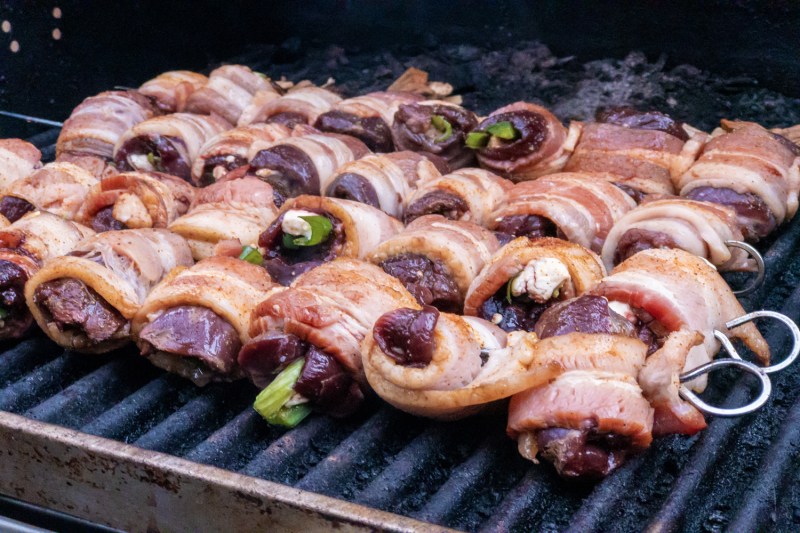
(Courtesy of Chef Isaac Toups)
We’re starting off the list with one of the most delicious yet under-used meats on the grill: duck. Not only duck but duck wrapped in bacon. Need we say more? Thank you, chef Isaac Toups, owner of Toup’s Meatery in New Orleans, for this decadent, grilled delight.
Ingredients
- 4 (4-ounce) skinless duck breasts (from 2 medium-size ducks)
- 1 tablespoon kosher salt
- 1 teaspoon ground black pepper
- 1 jalapeno, seeded and split lengthwise into quarters
- 8 slices bacon (thinner cuts from the grocery store are best so the duck doesn’t dry out before the bacon is cooked)
Method
- Soak 8 wooden skewers in water for 10 minutes.
- Preheat the grill to medium (around 400 degrees Fahrenheit).
- Season the duck breasts with salt and pepper, equal amounts on both sides.
- With a boning knife or a thin paring knife, make a slice all the way through the middle of a breast, creating a pocket through the length of the breast. (Imagine the duck breast is an iPhone lying flat. Place the knife at the bottom where the charger would go and pierce straight through the duck breast to the other side.)
- Shove the quartered piece of jalapeño into the pocket.
- Lay two pieces of bacon side by side lengthwise on a cutting board. Place a duck breast at the bottom end of the bacon, with the jalapeño pocket perpendicular to the bacon.
- Roll the duck breast up in the bacon slices. Secure the bacon in place with two skewers, one per piece of bacon. Repeat with each duck breast.
- Place the bacon-wrapped duck breasts on the grill and cook for 3 to 4 minutes on each side, until the internal temperature is 125 degrees Fahrenheit for medium.
- Pull off the grill and let rest for 1 minute.
- Remove the skewers, slice each breast into 1/2-inch-thick medallions, and serve.
- Pop ’em in your mouth like meat candy.
Bar-B-Que grilled cabbage
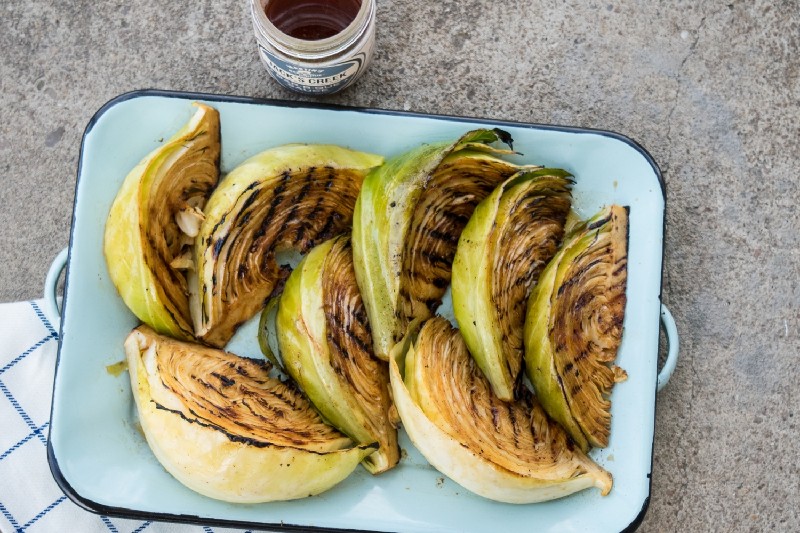
(Courtesy of Martin’s Bar-B-Que Joint)
Switching from duck to cabbage may seem a bit drastic, but don’t knock it until you try it. This barbecued cabbage is simple, delicious, and the perfect sweet and smoky side dish for any grilled or smoked main course.
Ingredients
- 1 head green cabbage
- 1/2 cup Martin’s Bar-B-Que Jack’s Creek Sauce (or similar sweet/spicy/tangy sauce)
- 1/4 cup olive oil
- 1 tablespoon kosher salt
Method
- Remove any loose outer leaves and place the head of cabbage, core facing up, on a cutting board.
- Using a sharp chef’s knife, cut cabbage in half, directly through the middle of the core.
- Cut directly through the center core on each section again, and one more time after that, ending up with eight pieces, all held together by a sliver of the core. Set aside.
- Add the Jack’s Creek, olive oil, and kosher salt into a shallow baking dish and whisk together with a fork.
- Place he cabbage wedges in a dish, cut the sides down, and then press into the marinade.
- Flip them over so that the other cut side soaks up more of that tasty Jack’s Creek marinade. Set aside.
- Preheat your grill to medium heat. Once hot, carefully place cabbage wedges on the grill, flat side down.
- Grill for about 5 minutes on each side or until dark grill marks have formed and the cabbage is fully cooked and tender.
- Remove from grill and serve.
Smoked turkey breast
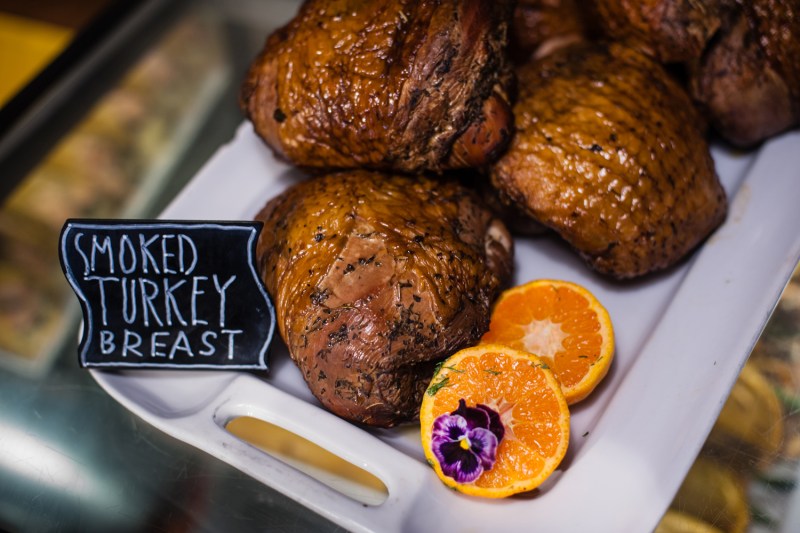
(Courtesy of Sam Jones)
Smoked turkey is one of those things that we may only think to cook during Thanksgiving or buy in the deli aisle, but it’s a great piece of meat to smoke anytime. Pitmaster Sam Jones (Sam Jones BBQ, a North Carolina barbecue staple) brings us not only his recipe for smoked turkey but also his signature Rub Potion Number Swine meat rub.
Ingredients
Turkey
- 1 whole turkey breast, 4 to 5 pounds, skin removed
- 2 tablespoons Rub Potion Number Swine
Rub Potion Number Swine
- 1 cup paprika
- 1 cup light brown sugar
- 1/2 cup salt
- 1/4 cup ground black pepper
- 1/4 cup garlic powder
- 1/4 cup ground mustard
- 1/4 cup chili powder
- 1 tablespoon ground onion powder
- 2 tablespoons cayenne pepper
Method
Rub Potion Number Swine
- In a bowl, mix all the ingredients together well with a whisk or with gloved hands.
- Toss generously on any barbecue you cook, except the whole hog.
- Any remaining rub can be stored in a sealed container in a cool, dry place for several months.
Turkey
- Preheat a smoker to 250 degrees Fahrenheit.
- Sprinkle the turkey breast generously on all sides with the rub.
- Place the breast on the rack and cook it for about 90 minutes, or until it turns the right mahogany color. We’re not looking for jet black here. The internal temperature should be 130 degrees Fahrenheit.
- Wrap the turkey tightly in foil, flip it over, and place it back in the smoker until the internal temperature is 165 degrees Fahrenheit — 45 to 60 minutes longer.
- Remove the foil and retain the collected juices. Let the turkey rest for 30 minutes.
- Slice, then pour the collected juices over the sliced meat. Serve.
Smoked guacamole with chia seed totopos (tortilla chips)
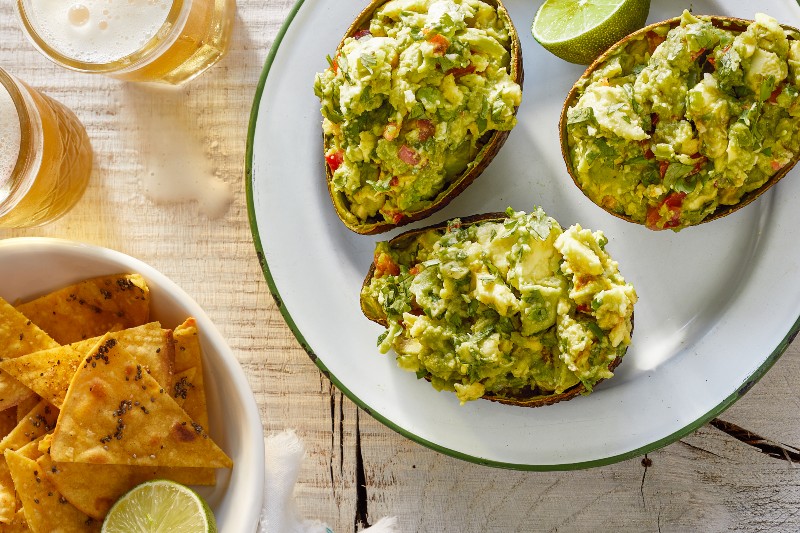
(Courtesy of Steven Raichlen)
This is a smoky take on guacamole from the cookbook How to Grill Vegetables: New Bible for Barbecuing Vegetables over Live Fire by Steven Raichlen. This cookbook is more of an encyclopedia, with detailed lessons on grilling and smoking virtually every veggie under the sun. This completely from scratch dish is delicious and easy to scale up for more people. Don’t be intimidated by the number of steps in this recipe; it’s way easier than it looks at first glance. Raichlen purposely makes his recipes very detailed to ensure your dish comes out perfect every time.
Ingredients
Guacamole
- 2 ripe avocados
- 3 tablespoons fresh lime juice (from 1 to 2 limes)
- 1 luscious ripe red tomato
- 1 jalapeño pepper
- 1 clove garlic, peeled (optional)
- 1 teaspoon minced canned chipotle chile in adobo
- 1/3 cup chopped fresh cilantro leaves
- Coarse salt (sea or kosher) and freshly ground black pepper
- Grilled chia seed totopos (recipe follows) or other chips for serving
- Vegetable oil for oiling the grill grid if wood grilling
Grilled chia seed totopos (tortilla chips)
- Vegetable oil for oiling the grill grate 4 small (6-inch) flour or corn tortillas
- Extra virgin olive oil or toasted (dark) sesame oil for brushing
- 3 tablespoons chia or sesame seeds
- Coarse salt (sea or kosher) and freshly ground black pepper (optional)
Method
Guacamole
- Set up your grill for indirect grilling (or your smoker for smoking) and heat to medium-low. Add wood chunks or chips to the coals. If enhancing a gas fire, place the chunks under the grate directly over one of the burners or add the chips to your gas grill’s smoker box.
- Meanwhile, halve and pit the avocados, but leave the skin on. Rub the cut sides of the avocados with a bit of the fresh lime juice to keep them from discoloring; set the remaining juice aside.
- Cut the tomato in half width-wise.
- Cut the jalapeño in half lengthwise (remove the seeds for milder guacamole; leave them in if you like more heat).
- Place the avocado, tomato, and jalapeño halves, cut sides up, on a wire rack over an aluminum foil pan filled with ice. (This keeps them cool during smoking.)
- Place the ice-filled pan with the vegetables on the grate away from the heat.
- Place the garlic clove (if using) atop one of the tomato halves.
- Lower the lid and smoke-roast (indirect grill) the vegetables until infused with smoke, 10 to 15 minutes. Don’t overcook — you want the avocados and tomatoes to remain cool in the center.
- Transfer the smoked vegetables to a cutting board and let cool.
- Scoop the avocado flesh out of the skins with a spoon (optional: save the skins for serving).
- Dice the tomato, discarding the stem end. Stem and mince the jalapeño and garlic (if using).
- Traditionally, guacamole would be made and served in a pumice stone mortar called a molcajete. If you have one, add the jalapeño, garlic, and chipotle chile and grind to a paste with the stone pestle (the latter is called a temolote). Work in the avocado, leaving it a little chunky. Work in the tomato, cilantro, lime juice, and salt and pepper to taste: The guacamole should be highly seasoned.
- Alternatively, chop the vegetables by hand and mash them in the avocado with a fork.
- Or use a food processor: Combine the jalapeño, garlic, and chipotle in a food processor and finely chop, then add the avocado and pulse the processor in short bursts to coarsely chop. Work in the tomato, cilantro, lime juice, and salt and pepper — again, running the processor in short bursts: The guacamole should remain chunky.
- Transfer the guacamole to a bowl (or serve directly in the molcajete or the smoked avocado skins). Serve with the grill chia seed totopos.
Grilled chia seed totopos
- Set up your grill for direct grilling and heat to medium-high.
- Brush or scrape the grill grate clean and oil it well.
- Lightly brush the tortillas on both sides with olive oil and sprinkle with chia seeds and salt and pepper (if using).
- Arrange the tortillas on the grate and grill until lightly browned on both sides, 1 to 2 minutes per side. Do not let them burn.
- Transfer the hot tortillas to a cutting board and immediately cut each into 6 wedges.
- Transfer the wedges to a wire rack — they’ll crisp upon cooling. I eat them right away, but any stragglers can be stored at room temperature in a resealable plastic bag or airtight container for a day or so.
Grilled lamb chops with chimichurri sauce and rosemary salt
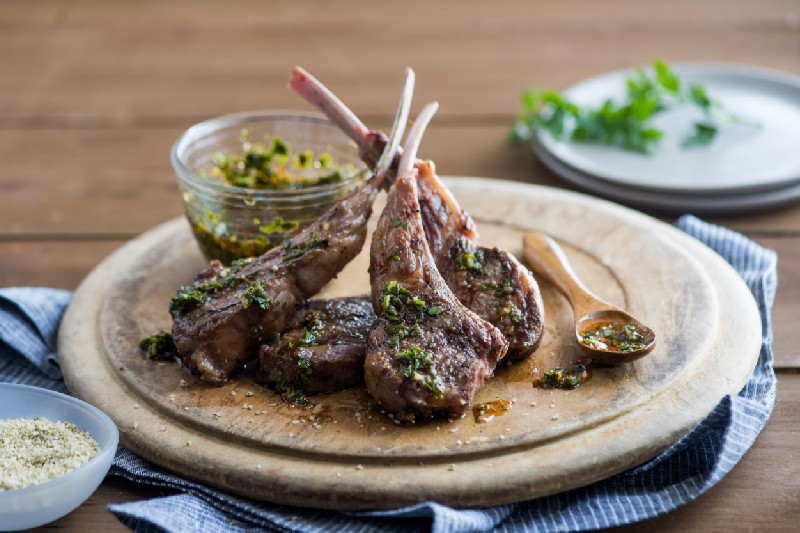
(Courtesy of Mark Zoske)
When cooked properly, lamb chops are one of the most visually appealing and mouth-watering dishes around. This recipe from Mark Zoske (owner of Saltworks) is easy to prep and cooks up quickly. With this recipe, you can spend more time at the party and less time tending to the grill.
Ingredients
- 4 lamb chops, each about ½ inch thick
- 1/4 cup olive oil
- 1 large clove of garlic, minced
- 1 teaspoon Spanish rosemary salt, divided (or use a blend of fresh rosemary and sea salt)
- 1/4 teaspoon smoked paprika
- 1/4 teaspoon crushed red pepper flakes
- 1/4 cup minced fresh parsley
- 1 tablespoon lemon juice
- 1/4 teaspoon fresh cracked black pepper
Method
Chimichurri sauce
- In a bowl, combine olive oil, garlic, 1/4 teaspoon Spanish rosemary salt, smoked paprika, red pepper flakes, parsley, and lemon juice. Set aside.
Lamb
- Season lamb chops with remaining ¾ teaspoon Spanish Rosemary Salt and black pepper.
- Heat grill or grill pan on high heat.
- Cook lamb chops on the first side for about 3 minutes. Flip them to cook the other side for 2-3 minutes or until desired doneness.
- Serve with chimichurri sauce on top of lamb chops.
- Season with additional Spanish rosemary sea salt to taste.
Legendary smoked chicken thighs
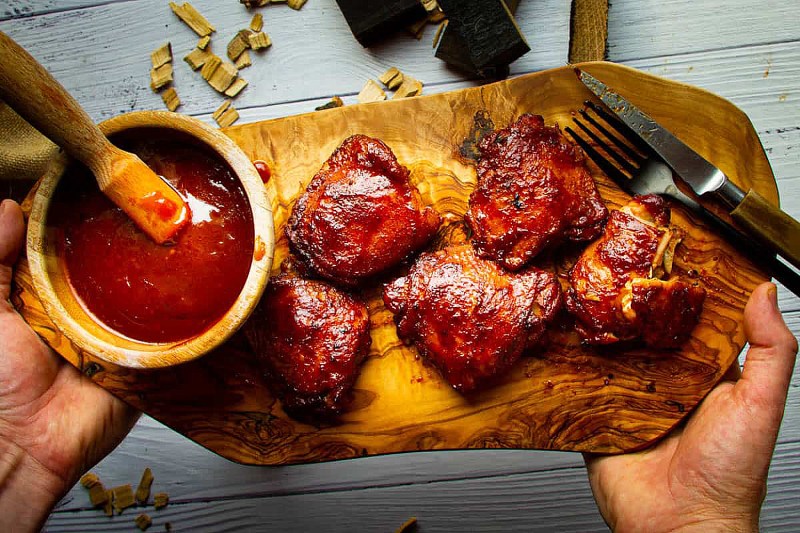
(Courtesy of Chef Devon Cameron)
Chicken thighs (skin on and bone in) are an often overlooked gem in the smoking and grilling world. Chef Devon Cameron of Braised and Deglazed is looking to change that with his Legendary chicken thighs recipe, which in all honesty, lives up to its name. If you’re looking for a crowd-pleasing dish, you can’t go wrong with this one.
Ingredients
Marinade
- 6 pieces chicken thighs skin on, bone in
- 2 pieces oranges juiced
- 2 tablespoons soy sauce
- B&D BBQ Spice Rub
- 1 tablespoon palm sugar or brown sugar
- 2 tablespoons paprika mild
- 1 teaspoon celery salt
- 1/2 teaspoon cayenne
- 1 teaspoon aleppo chili or ½ tsp normal ground chili
- 1 teaspoon garlic powder
- 1 teaspoon black pepper
- 1/8 teaspoon ground cinnamon
- 1 teaspoon ancho chili powder
Barbecue dip
- 1 cup barbecue sauce (use your favorite brand)
- 2 tablespoons sherry vinegar or red wine vinegar
Chicken
- 1 teaspoon salt
- 100 grams butter in 6 cubes
Method
- Rub the barbecue spice blend in the chicken thighs and mix well. Don’t season with salt until you are ready to barbecue.
- Juice the orange and add it to the chicken thighs along with the soy sauce. Line them skin side up in a barcecue tray with the marinade. Refrigerate for 2 hours or overnight.
- To fire up the grill, fill the fire chimney a little more than halfway with charcoal and light it with one fire starter underneath.
- After about 15 minutes, the coals should be red hot. Using heat-resistant gloves or a kitchen towel, carefully pour the hot coals to one side of the barbecue.
- If using a thermometer, set it up now as close to the middle of the barbecue as possible. Once the temperature reaches 350 degrees Fahrenheit, add the wood chunks. *If using an electric smoker, bring it to 300 degrees Fahrenheit. The grill will lose a lot of heat once it’s opened. I start the fire with all the air valves open to get it going and bring them down to about 1/4 open once it’s up to temperature. Keep a close eye on the temperature using your digital thermometer and either open the valves to increase the temp or close them slightly to tame the fire.
- Remove the chicken from the fridge. Season with sea salt on all sides. Put 1 cube of butter on each chicken thigh.
- Smoke the chicken, uncovered for 30 minutes at 300 degrees Fahrenheit.
- Cover the chicken with a lid or with aluminum foil. Place back in the smoker for 90 minutes at 300 degrees Fahrenheit.
- Once the chicken is ready, add the barbecue sauce plus the vinegar together in a small pot and bring to a simmer.
- Let the chicken and sauce cool slightly until it’s hot enough to handle. Carefully remove the chicken from the braising dish and dip into the warm barbecue sauce using gloves or with a fork. Be careful when lifting the chicken as it’s so tender it may fall apart!
- Move the charcoal around a little to give it some air and get it hot. If there are still some wood chunks left, move them around to get them smoking again or add another chunk.
- Finish the chicken thighs directly on the grill with a final smoking at the same 300 degrees Fahrenheit for about 10 to 15 minutes.
- Let the chicken rest for about 5 minutes before eating and wondering why you didn’t make more of these. Enjoy!
Cherry fire-glazed cedar-planked salmon
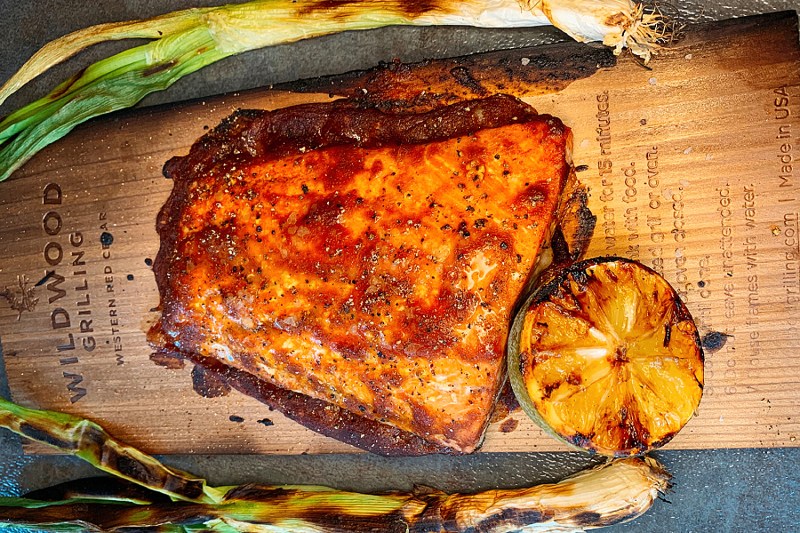
(Courtesy of Lori Monigold)
When grilling and smoking, it’s crucial not to forget about our friends from the sea. This cedar-planked recipe from Wildwood Grilling is delicious, easy, and virtually foolproof. Using cedar planks soaked in water for smoking or grilling is beneficial in two main ways. First, the water inside the plank releases steam into your food, making it moist. Second, along with the steam, the wood flavor of the plank is infused into your meats, veggies, and fruits.
Ingredients
- Cedar grilling plank
- 2 salmon filets with skin
- 2/3 cup sugar-free black cherry soda
- 2/3 cup sugar-free ketchup
- 1/2 teaspoon each salt, garlic powder, onion powder
- Black pepper to taste
- 1 tablespoon Nectar Fire Tonic (we suggest apple cider vinegar as a substitution in a pinch)
- 1 lime, halved
Method
- Soak the grilling plank in warm water for 15 minutes.
- Make the glaze by combining soda, ketchup, and seasonings in a pot.
- Bring to a boil and reduce to a simmer until the glaze becomes nice and thick.
- Preheat the grill to medium-high heat.
- Let planks get a slight char and add salmon skin side down. Season with salt and pepper.
- Place limes cut side down on the grill and cook until charred.
- Heat the glaze on the grill and whisk in the nectar fire tonic. Brush the salmon with the glaze and cook with the lid closed for 10 to 12 minutes, reapplying the glaze one or two more times.
- Serve with a grilled lime squeeze, and enjoy!!!
Brown sugar ribs
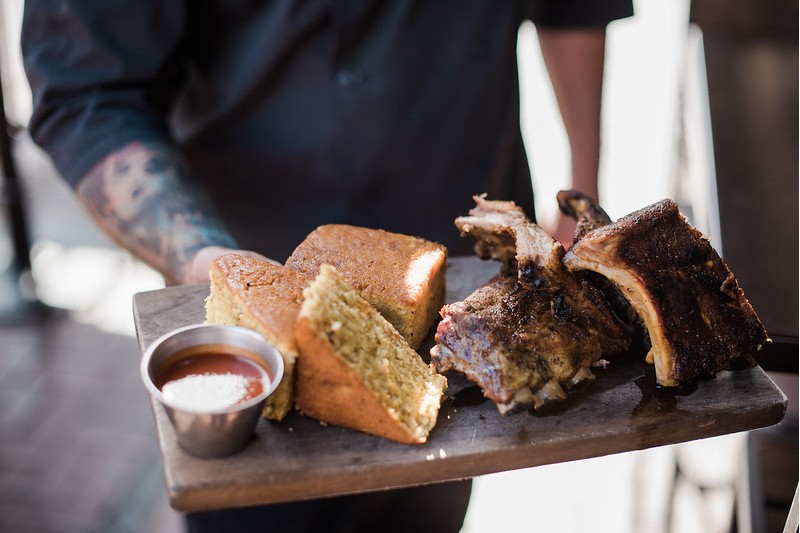
(Courtesy of Executive Chef Kevin Templeton)
What kind of best smoking and grilling recipes would be complete without a recipe for fall-off-the-bone ribs? These Brown Sugar ribs from executive chef Kevin Templeton (barlymash, San Diego, California.) are just the ticket. He uses bacon fat in his recipe to achieve moist and fall-off-the-bone tender results. This recipe can be used on a grill or smoker and can be thrown together quickly.
Ingredients
- 2 racks baby back pork ribs
- 2 cups brown sugar
- 2 tablespoons salt
- 2 tablespoons fresh ground pepper
- 2 tablespoons ancho chili powder (optional)
- 1 pound bacon fat, cold or at room temperature
- Barbecue sauce (optional)
Method
- If your butcher has not already done so, remove the thin membrane from the back of each rack of ribs.
- In a small bowl, mix together brown sugar, salt, and pepper. Generously rub the mixture into both sides of the ribs, then coat with bacon fat.
- Place 2 racks of ribs side by side in two to three layers of heavy-duty aluminum foil, making sure there are no holes or tears. Wrap securely and crimp the edges of the foil to seal. Repeat the process with the remaining ribs.
- Place packets on a grill over low heat and cook for at least 30 to 40 minutes or until ribs are fall-off-the-bone tender, turning every 5 minutes.
- Remove packets from the grill. Carefully open the packets, remove the ribs and discard rendered fat and foil. Return ribs to grill to char.
- Serve dry or with your favorite barbecue sauce!
Grilled octopus marinated in ginger
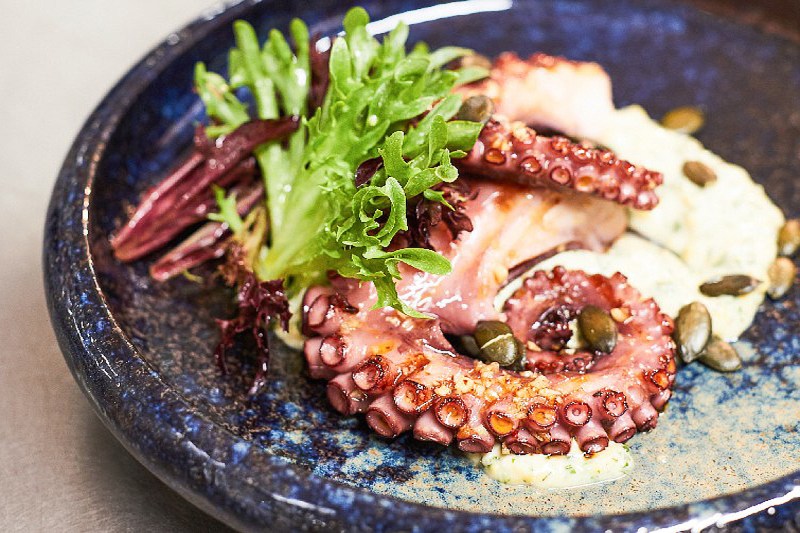
(Courtesy of Executive Chef Gil Dumoulin)
This is definitely one of those recipes you can impress your friends and family with your next-level culinary skills. One of the primary reasons people don’t grill octopuses as much as they should is because it seems more difficult to source than it actually is. You can find frozen, pre-cooked octopuses (tentacles) at many Asian markets and higher-end supermarkets, or you can order them directly online. This recipe delivers a party directly to your mouth with an array of flavors and textures. This dish has pleased many party-goers at the Hôtel Barrière Le Carl Gustaf in St. Barth.
Ingredients
- 500 grams (17.64 ounces) of cooked octopus
- 3 cloves of garlic
- 2 hot onion stalks
- 40 grams of fresh ginger
- Extra virgin olive oil
- 1 pinch of traditional Indian curry
- Fleur de sel salt
- Ground pepper
Method
Marinade
- Peel the garlic cloves, remove the germ and grate with a fine grater.
- Peel the ginger, grate with a fine grater, and finely chop the chives.
- Add a pinch of traditional curry as well as fleur de sel and ground pepper.
- Add the olive oil to cover the surface of your dish.
- Remove the cooked octopus from its wrapping, drain and place it in your marinade. I recommend letting the octopus soak in the marinade for at least 25 minutes before cooking (in the open area) or marinating it the day before cooking (in the refrigerator). Remember to marinate it on each side while balancing the marinade time per side.
Octopus
- Place the octopus tentacles over hot coals, while making sure the flames do not burn the flesh to the extreme. As the octopus has previously been cooked, the idea is to grill it in order to bring crispiness and reveal all its flavors and aromas. The use of the barbecue will provide an extra subtle grilled taste.
Grilled broccolini
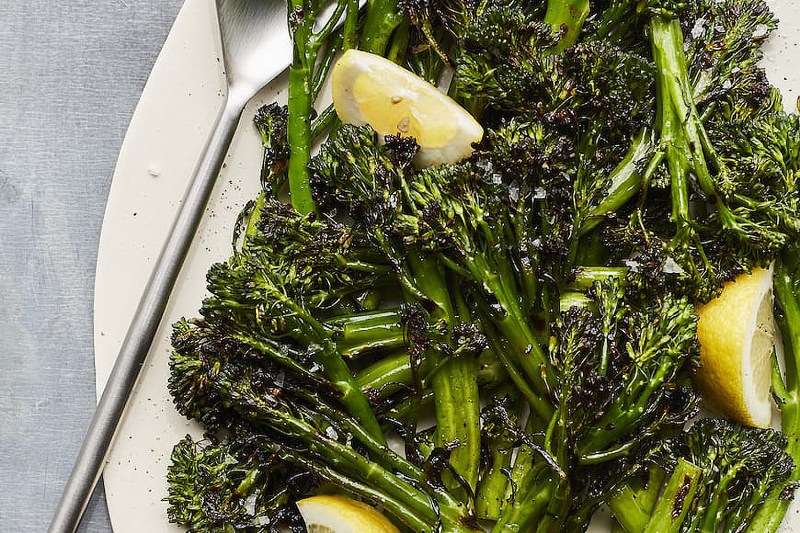
(Courtesy of Executive Chef Chris Schaefer)
If the previous recipes didn’t get grilled/smoked veggies on your radar, we hope this one will. Chef Chris Schaefer of Geraldine’s in Austin, Texas, brings us this recipe. All you really need on broccolini is a good char and a bit of your favorite seasonings to make the flavor of this member of the mustard family stand out. Chef Schaefer enjoys a bed of yuzu cashew butter on the bottom of the plate topped with a garnish of serrano chilies and furikake.
Ingredients
- 1 bunch broccolini
- 1/2 gallon water
- Salt, pepper, and olive oil (to taste)
Method
- Trim broccolini stems 1/2 inch.
- Bring 1/2 gallon of salted water to a boil and add one bunch of broccolini.
- Cook until tender, then chill in ice water. Remove and drain. Refrigerate until ready to use. Can be prepared 48 hours in advance.
- When ready to grill, make sure the grill is at its hottest to achieve a nice char on the broccolini. This will impact flavor. Be on the lookout for char marks, meaning spots that are getting dark but not burnt all the way around.
- Remove and cut the broccolini while it’s still warm.
- Toss with extra virgin olive oil, salt, and pepper.
Reverse seared tri-tip
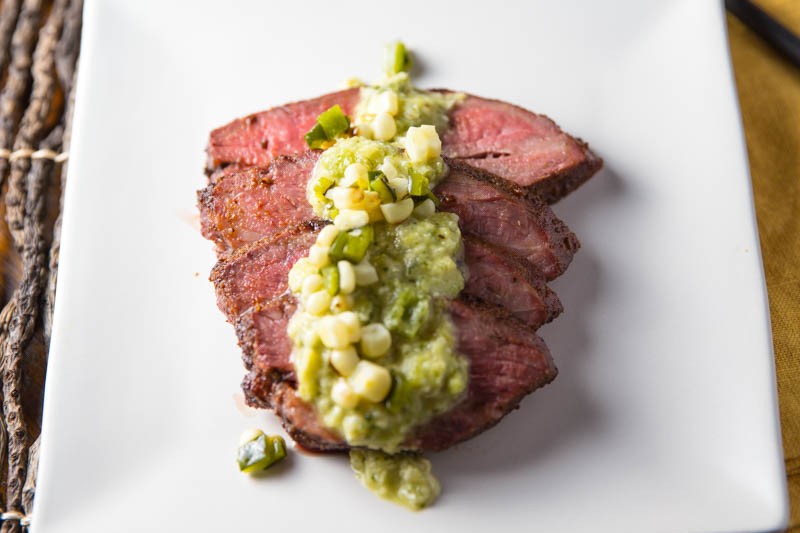
(Courtesy of Chris Sussman)
We’re rounding out the list with a super-easy yet super-delicious recipe from the BBQ Buddha, pitmaster Chris Sussman. If you’re unfamiliar with the current grilling/smoking trend of reverse searing, here’s a quick rundown. You can reverse sear thick cuts of beef with some lesser-known cuts of beef, like the tri-tip, by first grilling/smoking the meat at low temp until it reaches rare to mid-rare. Then, you finish it off by giving it a heavy sear in a cast iron.
Ingredients
- 2 pounds tri-tip
- Olive oil
- Your favorite barbecue rub
Method
- Rub the roast with olive oil and your favorite barbecue rub.
- Let the roast sit for 3 hours until it gets to room temperature.
- Preheat your grill to 300 degrees Fahrenheit.
- Cook the tri-tip indirect for 45 minutes or until the internal temp measures 130 degrees Fahrenheit.
- Sear the tri-tip in a cast-iron pan for 2 minutes per side.
Can you use the same grill for smoking and grilling meat?
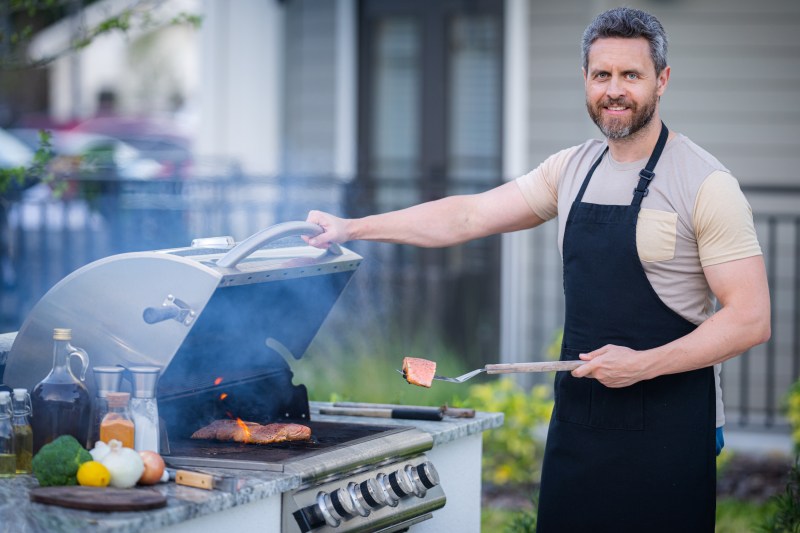
Yes, you can definitely use the same grill to do both, but it depends on the type of grill you have and the results you’re looking to achieve. Here are more details about each type of grill.
Gas grills
You can grill on a gas grill and achieve a smoky flavor to some extent by using smoker boxes with wood chips or adding smoke pouches directly to the grates. However, achieving true low-and-slow smoking temperatures (around 225 degrees Fahrenheit) can be difficult on a gas grill because they’re designed for high heat.
Charcoal grills
You can use a charcoal grill for both grilling and smoking. To smoke, you can use indirect heat by placing the coals on one side of the grill and the meat on the other side. You can also add wood chips or chunks to the coals for smoke flavor. Charcoal grills offer more temperature control than gas grills for smoking.
Pellet grills
Pellet grills are very versatile, and you can use them for smoking and grilling. They use wood pellets as fuel, which infuses the food with smoke flavor. Pellet grills offer precise temperature control, making them ideal for low-and-slow smoking.
Electric grills
Electric grills aren’t ideal for smoking because they generally don’t get hot enough and don’t produce the smoke flavor you’re looking for.
Smoker grills
Smoker grills, as the name suggests, are specifically designed for smoking meat and aren’t very effective for grilling. They use indirect heat and low temperatures to slowly cook meat and infuse it with smoke flavor.



